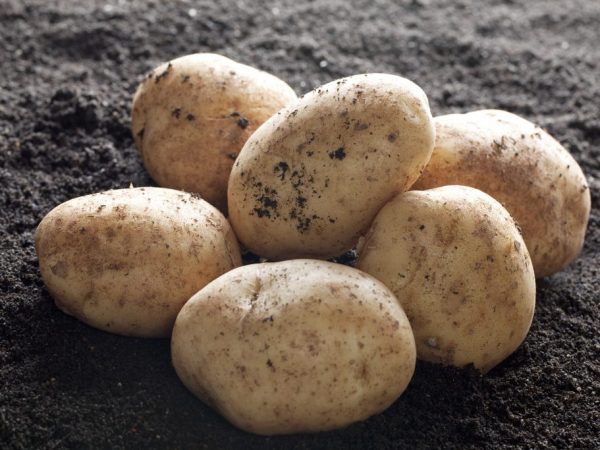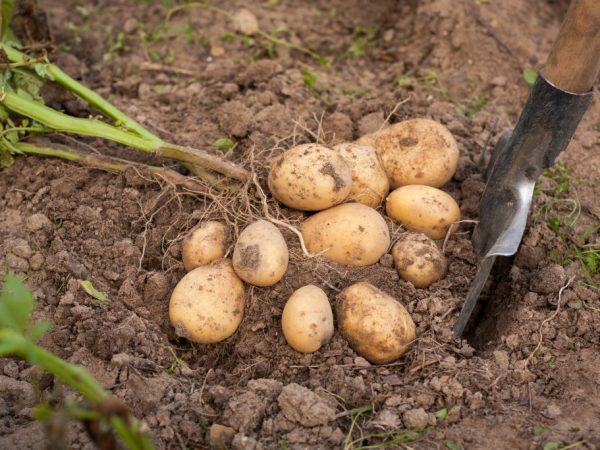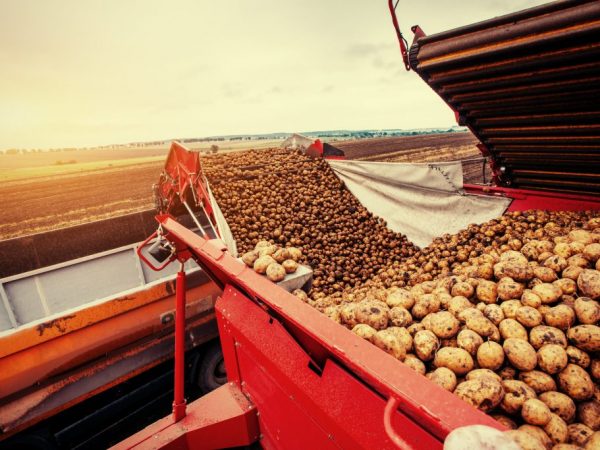Timing and methods of harvesting potatoes
Caring for potatoes also involves harvesting. Harvesting potatoes from the field should be done in a timely manner. If you Overexpose the tubers in the ground, then there is a high probability of the appearance of various diseases. If you collect unripe tubers, then a dense peel will not have time to form, which will negatively affect the keeping quality of the crop. Consider in what time frame a given vegetable crop should be harvested, and what specialized equipment can be involved during harvesting.

Timing and methods of harvesting potatoes
Cleaning time
According to agrotechnical requirements, the timing of potato harvesting depends on several factors. The most important of these are the potato variety and weather conditions. Let's consider each of them separately.
Potato variety
Each variety has its own ripening period. In general, all varieties are divided into 5 groups.
- Early ripe. The growing season for early maturing varieties lasts about 67 days. Accordingly, we remove early ripe potatoes in July or August. Before you start harvesting, you should dig in a few bushes and look at the size of the tubers. If their diameter is 3 cm or more, you can start digging.
- Medium early. Ripen in 73 days. They are ready, as a rule, by the end of August.
- Mid-season. They can be harvested 83 days after planting.
- Medium late. Cleaning times vary from 15 to 120 days after planting. Harvesting time for these potatoes usually falls in September.
- Late ripening. The growing season is 135 days. Harvest late-ripening varieties in the fall.
If you overexpose potatoes in the ground, then they will slightly decrease in weight. Also, the harvest harvested later than the term is stored much worse.
Weather and climatic conditions
We take into account the weather forecast for the first autumn months. If it rains, then we start harvesting work before they start. If you delay the harvest, the gross harvest of healthy potatoes will decrease. Early frosts will also negatively affect the keeping quality of potatoes. We dig out the harvest in dry and sunny weather. It is best to dig up the potatoes during Indian summer. This should be done on a warm and sunny day.
In different regions of our country, climatic conditions are different. In some areas the summer is long, in some it is short. Therefore, the ripening time of potatoes varies. The main guideline for the farmer should be the condition of the tops. As soon as the leaves begin to wilt and the stems lie on the ground, it's time to start harvesting. Before harvesting potatoes, it is advisable to mow the tops. We start digging the tubers 2 weeks after harvesting the tops. This time is enough for the skin of the tubers to become rough.
It is also worth noting here that you should carefully select the varieties of potatoes for growing. For example, the Krasnodar Territory is famous for its long and warm summer, so any variety will do.But in the Ryazan region, the summer is short and cold. The best varieties for this region are Nevsky, Iskra. Pay attention to what kind of crop in your region the selected variety gave in 2016 and 2017.
Purpose of potatoes

We harvest with green tops
Affects the timing of harvesting potatoes and its purpose. Areas intended for growing planting material are harvested before the tops dry out. But, at the time of harvesting the potatoes, flowering should already be over, since during flowering, the underground part of the plant actively grows and develops. Potatoes intended for human consumption are harvested after the tops have wilted.
It is important to reject all damaged and diseased tubers when collecting seed material. It is advisable to feed sick potatoes to your own animals or birds. Damaged potatoes can be eaten. But it has a short shelf life. Therefore, you need to eat it first.
We store the potatoes that will be used for seeds in the new season separately. We pre-process it with copper sulfate diluted in water. Such treatment will prevent the appearance of fungal diseases. If it is not possible to prepare planting material, it is advisable to purchase it from a peasant farm (peasant farm).
How to speed up the process
Sometimes you need to speed up the ripening process. Such a need arises if the harvest should be ready by mid or late September, but September is expected to be rainy. It is more expedient in this case to dig out the harvest in August. You can accelerate the ripening of a vegetable crop using:
- Copper sulfate, which is sprayed on the bush 14 days before harvest. For 1 liter of water, 5 grams of the chemical is taken.
- Magnesium chlorate, which is sprayed on bushes 5 days before harvest. We take 20 grams of the chemical for 1 liter of water.
- Superphosphate. For 5 liters of water, 1 kg of fertilizer is taken.
Experts recommend artificially accelerating the ripening of a culture only in exceptional cases.
You should not ignore the lunar calendar, which indicates auspicious days for harvesting. These terms change every year.
Harvesting methods
Harvesting is carried out in two ways: manual and mechanized.
Hand picking
Harvesting potatoes by hand takes a lot of time and effort. It should be used only if it is not possible to work with special equipment in the garden. And you cannot use agricultural machinery if only part of the tops is lodged, and the rest of the bushes are still in the ripening stage. This happens if varieties of different groups are planted together (for example, early and mid-season). It is still not possible to use a potato digger if the distance between the rows is different.
Choose a tool for digging potatoes in accordance with the type of soil. On light and crumbly soils, we use a pitchfork. On heavy soils, which include black soil, we use a shovel. With manual digging, you do not need to remove weeds or tops.
With manual harvesting, you can sort the potatoes for storage right away. We sort the harvest by varieties and sizes of tubers. We eat early varieties in September-October. The longest shelf life is in late-ripening varieties. We leave them for winter storage. As for the size of tubers, first eat small tubers, then large ones. Medium tubers are stored for the longest.
Mechanized collection
Harvesting mechanization saves time and effort. V.P. Avdeev made a great contribution to the process of agricultural mechanization. But this technology is not always applicable. You can use agricultural machinery in areas where potatoes are planted in even rows, and the row spacing is the same. If these conditions are met, then a potato digger can be used. But, we take into account that the harvester digging requires preliminary preparation of the beds. We'll have to mow the tops and weeds.
A special technique cuts the top layer of soil in which the ripe tubers are located and sends it to a special compartment. There, through vibration, the separation of crop and land takes place.
Selection of agricultural machinery

Technique to help
The organization of harvesting involves a careful selection of equipment.
Equipment autonomy and functionality
There is passive equipment that clings to a walk-behind tractor or a mini tractor, and there is an operating and technological machine that performs several functions (planting, hilling, harvesting). All potato diggers are divided into single-row and multi-row devices. With the help of the first, each row is dug separately. With the help of multi-row devices, several rows are dug out at the same time. When choosing a technique, we take into account how much land needs to be cultivated. If the area of the potato field exceeds 20-30 acres, then it is advisable to use 4 or 6-row potato diggers. It is also worth noting that large areas, the area of which is more than 1 hectare, can be processed with a combine or a tractor.
Harvesting compartment
Some potato diggers are equipped with a harvesting compartment, some do not. If there is no such department, then you will have to enlist the help of potato pickers, who will collect the tubers by hand. An alternative option is a potato harvester, which you will have to do yourself. There is no such equipment on sale. The collector is a box with a lattice bottom. On one side, the box is open, and has a long blade made of sheet steel, which shears off the top layer of soil. This layer contains the excavated crop. All that remains is to weed out the earth. To do this, it is enough to shake the box properly. But, this device will be effective only when working with dry soil.
Features of the use of technology
In order not to damage the crop, you need to properly set up the technique. The rules for the operation of any factory equipment are described in the instructions. It also describes how to configure the purchased equipment. In some potato diggers, you can change the working width (distance between rows) and digging depth. In some machines, only the digging depth is regulated.
If the working width of the equipment is not adjustable, then during planting we adjust the row spacing to the existing equipment.

